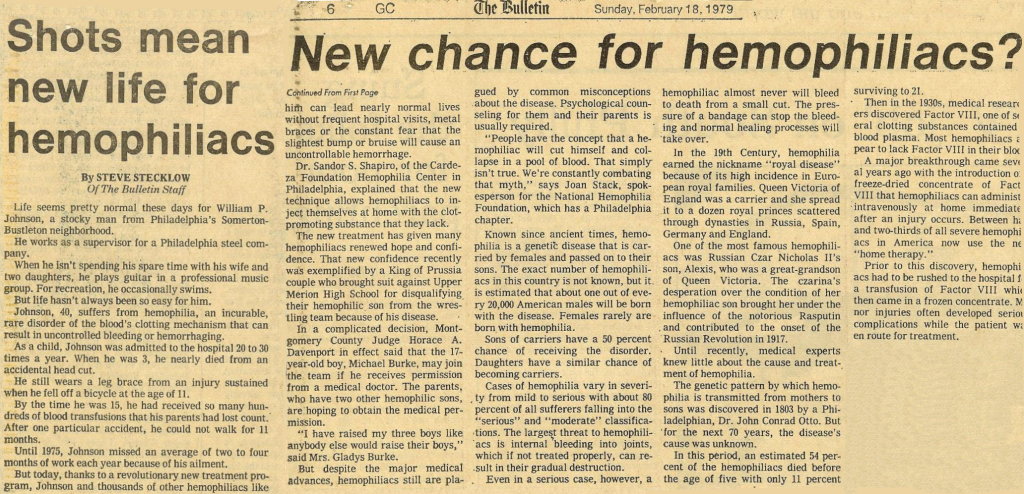Title:Â Doctor Claims 95% Accuracy in New Test for Hemophilia
By:Â UnknownÂ
Date:Â 1973
Source:Â Associate PressÂ
A researcher says a new method has been developed that offers a 95% chance of spotting female carriers of hemophilia (bleeding disorders) as compared with only 25% accuracy with present ways.
Hemophilia is a hereditary blood malady that strikes only men but is transmitted by women. It is characterized by a defect in the body’s blood clotting mechanism. 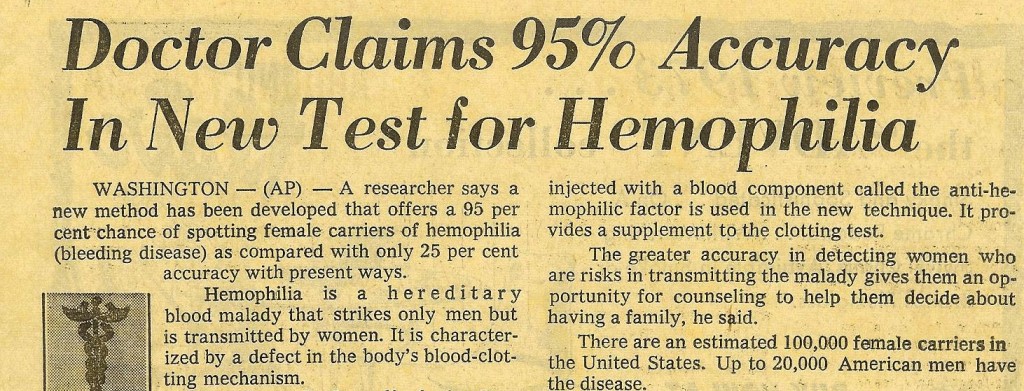 Dr. Oscan D. Ratnoff of Case Waster Reserve University in Cleveland told a news conference in Washington that the new method involves the combining of a new detection technique, developed by himself and Dr. Theodore Zimmeman of Case Western, with an older method.
Dr. Oscan D. Ratnoff of Case Waster Reserve University in Cleveland told a news conference in Washington that the new method involves the combining of a new detection technique, developed by himself and Dr. Theodore Zimmeman of Case Western, with an older method.
The older method measures the degree to which clotting is produced when plasma from normal human blood is added to a sample of plasma from a possible carrier. Ratnoff said this test is hampered by individual blood variations among both normal people and carriers.
A special ant-serum derived from rabbits first injected with a blood component called the anti-hemophiliac factor is used in the new technique.
It provides a supplement to the clotting test. The greater accuracy in detecting women who are risks in transmitting the malady gives them an opportunity for counseling to help them decide about having a family, he said.
There are estimated 100,000 females carriers in the United States. Up to 20,00 American men have the disease.
*Article courtesy of Ryan Crowe
___________________________________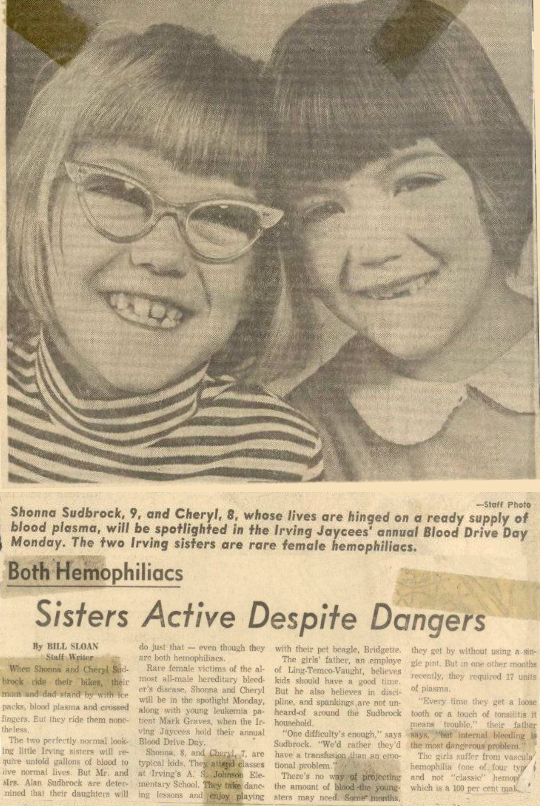 Â Title: Â Sisters Active Despite Dangers
 Title:  Sisters Active Despite Dangers
By:Â Bill Sloan
Date: 10/6/1968
Source:Â Dallas Times HeraldÂ
When Shonna and Cheryl Sudbrock ride their bikes, their mom and dad stand by with ice packs, blood plasma and crossed fingers. But they ride them nonetheless.
The two perfectly normal looking little Irving sisters will require untold gallons of blood to live normal lives. But Mr. and Mrs. Alan sudbrock are determined that their daughters will do just that – even though they are both hemophiliacs.
Rare female victims of the almost all-male hereditary bleeder’s disease, Shonna and Cheryl will be in the spotlight Monday, along with young leukemia patient Mark Graves, when the Irving Jaycees hold their annual blood drive.
Shonna, 8, and Cheryl, 7, are typical kids. The attend classes at Irving’s A. S. Johnson Elementary School. They take dancing lessons and enjoy playing with their pet beagle, Bridgette. The girls’ father, and employee of Ling-Temco-Vaught, believes kids should have a good time. But he also believes in discipline, and spankings are not unheard-of around the Sudbrock household.
“One difficulty’s enough,” says Sudbrock. “We’d rather they’d have a transfusion than an emotional problem.”
There’s no way of projecting the amount of blood the young sisters may need. Some months, they get by without using a single pint. But in other months recently, they required 17 units of plasma.
“Every time they get a loose tooth or a touch of tonsillitis it means trouble,” their father says, “but internal bleeding is the most dangerous problem.
The girls suffer from vascular hemophilia (one of four types, and not “classic” hemophilia) which is a 100 per cent [ending obscured].
*Article courtesy of Barry Haarde
___________________________________
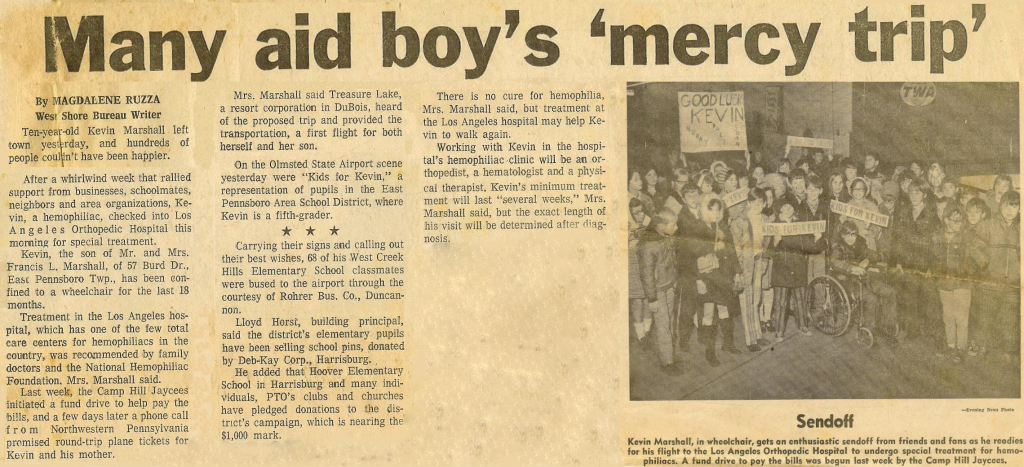
Title:Â Many Aid Boy’s ‘Mercy Trip’
By:Â Magdalene Ruzza
Date:Â November 24, 1970
Source:Â Unknown
Ten-year-old Kevin Marshall left town yesterday, and hundreds of people couldn’t have been happier.
After a whirlwind week that rallied support from businesses, schoolmates, neighbors and area organizations, Kevin, a hemophiliac, checked into Los Angeles Orthopedic Hospital this morning for special treatment.
Kevin, the son of Mr. and Mrs. Francis L. Marshall, of 57 Burd Dr., East Pennsboro Twp., has been confined to a wheelchair for the last 18 months.
Treatment in the Los Angeles hospital, which has one of the few total care centers for hemophiliacs in the country, was recommended by family doctors and the National Hemophiliac [SIC] Foundation, Mrs. Marshall said.
Last week, the Camp Hill Jaycess initiated a fund drive to help pay the bills, and a few days later a phone call from Northwestern Pennsylvania promised round-trip place tickets for Kevin and his mother.
Mrs. Marshall said Treasure Lake, a resort corporation in DuBois, heard of the proposed trip and provided the transportation, a first flight for both herself and her son.
On the Olmsted State Airport scene yesterday were “Kids for Kevin,” a representation of pupils in the East Pennsboro Area School District, where Kevin is a fifth-grader.
Carrying their signs and calling out their best wishes, 68 of his West Creek Hills Elementary School classmates were bused to the airport through the courtesy of Rohrer Bus, Co., Duncannon.
Lloyd Horst, building principal, said the district’s elementary pupils have been selling school pins, donated by Deb-Kay Corp., Harrisburg.
He added that Hoover Elementary School in Harrisburg and many individuals, PTO’s clubs and churches have pledged donations to the district’s campaign, which is nearing the $1,000 mark.
There is no cure for hemophilia, Mrs. Marshall said, but treatment at the Los Angeles Hospital may help Kevin to walk again.
Working with Kevin in the hospital’s hemophiliac clinic will be an orthopedist, a hematologist and a physical therapist. Kevin’s minimum treatment will last “several weeks,” Mrs. Marshall said, but the exact length of his visit will be determined after diagnosis.
___________________________________
Title: University Students Give Blood to Hemophiliac for 12 Years 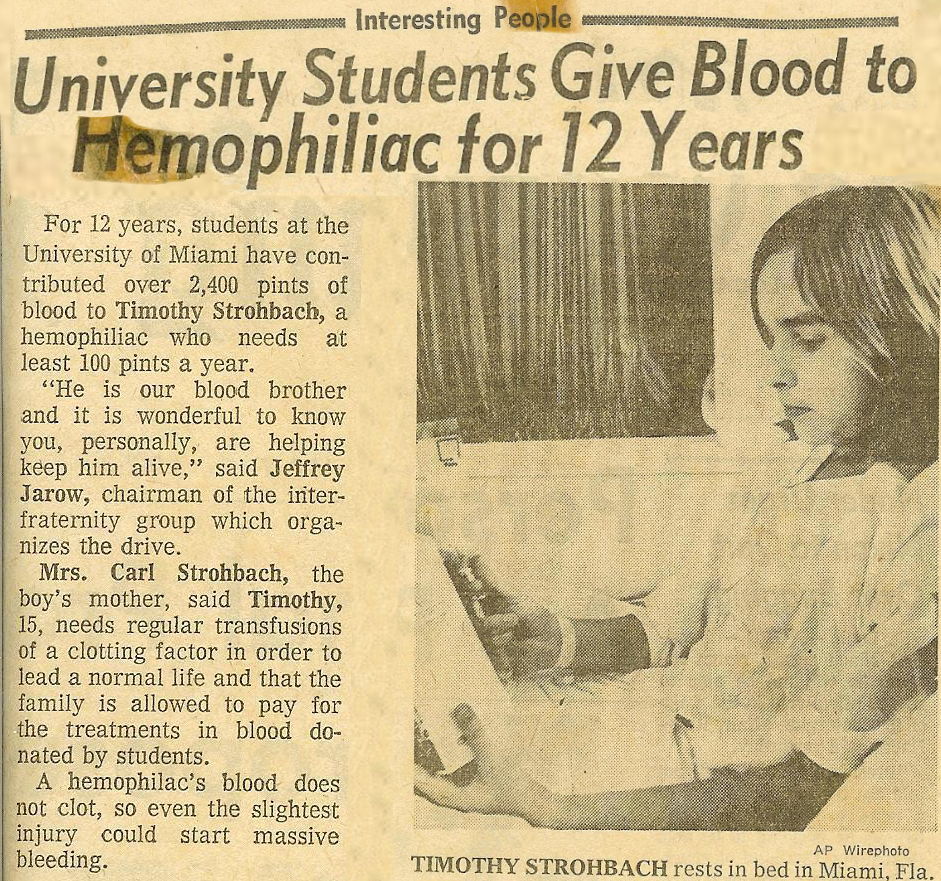
By:Â UnknownÂ
Date:Â Circa 1972
Source:Â Unknown
For 12 years, students at the University of Miami have contributed over 2,400 pints of blood to Timothy Strohbach, a hemophiliac who needs at least 100 pints a year.
“He is our blood brother and it is wonderful to know you, personally, are helping keep him alive,” said Jeffrey Jarow, chairman of the inter-fraternity group which organizes the drive.
Mrs. Carl Strohbach, the boy’s mother, said Timothy, 15, needs regular transfusions of a clotting factor in order to lead a normal life and that the family is allowed to pay for the treatments in blood donated by students.
A hemophiliac’s blood does not clot, so even the slightest injury could start massive bleeding.
__________________________________
 Title: Hemophiliacs now Emerging from Behind Closed Doors
Title: Hemophiliacs now Emerging from Behind Closed Doors
By:Â Unknown
Date:Â September 25, 1978
Source:Â Dallas Morning News
For years, many males who suffered from hemophilia, the hereditary blood disorder known as bleeder’s disease, stayed home and shut themselves of from everyday activities.
The constant fear that slight injuries or physical or emotional stress could cause bleeding within their bodies kept them from attending school or seeking jobs. Physical damage often was paralleled by emotional and social problems. Now, recent medical advances and a wave of comprehensive treatment programs for hemophiliacs is growing across the country – and it’s unlocking the doors.
“Hemophilia used to be such a dismal disease. It was almost a death within life,” said Dr. Peter Smith, director of the hemophilia program at Rhode Island hospital. “Now with the concerns of society and medical advances, we can make these kids almost normal again.”
The genetic blood disease strikes males but is transmitted by females. Spontaneous hemorrhaging is caused by an abnormally low level of clotting “factor”in their blood. Those with severe hemophilia often bleed into their joints, which can cause crippling.
In the past, bleeding episodes meant frantic trips to the hospital at any hour, and sometimes long waits. Treatment delays can cause permanent damage to joints, muscles and nerves.
Rhode Island is one of about 21 states that have developed comprehensive treatment programs for hemophilia. Classes teach entire families more about the disease and how to cope with it.
Patients, or parents in the cases of youngsters, are taught to administer doses of the factor as needed.
Besides home care, the program includes specially trained dentists, bone specialists, social workers and a physical therapist who helps rehabilitate the muscles of patients with joint problems.
The Rhode Island effort now serves about 40 hemophiliacs. It started in January after the legislature provided a $50,000 grant to set up the program.
The Rhode Island Hemophilia Foundation donated materials and helped locate its victims. Rhode Island Blue Cross agreed to finance the screening, medical exams, lab studies, and home care of member patients on a pilot basis.
The major breakthrough allowing home care was development of a new form of clotting factor – a freeze-dried blood extract that is injected into the bloodstream after being mixed with sterile water. Twenty years ago, whole blood had to be given by transfusion. Under the new program, patients are taught to recognize the “tingling feeling” that is n early warning of hemorrhaging. On hospital visits, patients exercise on the grounds and in the swimming pool. The greatest improvement is seen in youngsters.
“We encourage normal activities including physical education but no contact sports,” said Smith, a pediatrician who specializes in diseases of the blood.
Mrs. Frances Barbato of Burrillville says her two hemophiliac sons, Ronald Lindsey, 20, and Andrew, 7, “are trying things now that they wouldn’t dare before.”
Both boys are two years behind their normal grade levels in school because of time lost to treatments. Now in the home care program, both plan to attend school full time this fall.
Ronald was hospitalized 50 times before the program started. He hasn’t been admitted for treatment since January, plays softball and landed a summer job.
“I can go out now without worrying and do more than sit at home and watch TV,” he said.
__________________________________
Title:Â Shots mean new life for hemophiliacs
By:Â Steve StecklowÂ
Date:Â February 18, 1979
Source:Â The Philadelphia Bulletin
Life seems pretty normal these days for William P. Johnson, a stocky man from Philadelphia’s Somerton-Bustleton neighborhood.
He works as a supervisor for a Philadelphia steel company.
When he isn’t spending his spare time with his wife and two daughters, he plays guitar in a professional music group. For recreation, he occasionally swims.
But life hasn’t always been so easy for him.
Johnson, 40, suffers from hemophilia, an incurable, rare disorder of the blood’s clotting mechanism that can result in uncontrolled bleeding or hemorrhaging.
As a child, Johnson was admitted to the hospital 20 to 30 tunes a year. When he was 3, he nearly died from an accidental head cut.
He still wears a leg brace from an injury sustained when he fell off a bicycle at the age of 11.
By the time he was 15, he had received so many hundreds of blood transfusions that his parents had lost count. After one particular accident, he could not walk for 11 months.
Until 1975, Johnson missed an average of two to four months of work each year because of his ailment.
But today, thanks to a revolutionary new treatment program, Johnson and thousands of other hemophiliacs like him can lead nearly normal lives without frequent hospital visits, metal braces or the constant fear that the slightest bump or bruise will cause an uncontrollable hemorrhage.
Dr. Sandor S. Shapiro, of the Cardeza Foundation Hemophilia Center in Philadelphia, explained that the new technique allows hemophiliacs to inject themselves at home with the clot-promoting substance they lack.
The new treatment has given many hemophiliacs renewed hope and confidence. That new confidence recently was exemplified by a King of Prussia couple who brought suit against Upper Merion High School for disqualifying their hemophiliac son from the wrestling team because of his disease.
In a complicated decisions, Montgomery County Judge Horace A. Davenport in effect said that the 17-year-old boy, Michael Burke, may join the team if he receives permission from a medical doctor. The parents, who have two other hemophiliac sons, are hoping to obtain the medical permission.
“I have raised my three boys like anybody else would raise their boys,” said Mrs. Gladys Burke.
But despite the major medical advances, hemophiliacs still are plagued by common misconceptions about the disease. Psychological counseling for them and their parents is usually required.
“People have the concept that a hemophiliac will cut himself and collapse in a pool of blood. That simply isn’t true. We’re constantly combating that myth,” says Joan Stack, spokesperson for the National Hemophilia Foundation, which has a Philadelphia chapter.
Known since ancient times, hemophilia is a genetic disease that is carried by females and passed on to their sons. The exact number of hemophiliacs in the country is not known, but it is estimated that about one out of every 20,000 American males will be born with the disease. Females rarely are born with hemophilia.
Sons of carriers have a 50 percent chance of receiving the disorder. Daughters have a similar chance of becoming carriers.
Cases of hemophilia vary in severity from mild to serious with about 80 percent of all sufferers falling into the “serious” and “moderate” classifications. The largest threat to hemophiliacs is internal bleeding into joints, which if not treated properly, can result in their gradual destruction.
Even in a serious case, however, a hemophiliac almost never will bleed to death from a small cut. The pressure of a bandage can stop the bleeding and normal heling processes will take over.
In the 19th Century, hemophilia earned the nickname “royal disease” because of its high incidence in European royal families. Queen Victoria of England was a carrier and she spread it to a dozen royal princes scattered through dynasties in Russia, Spain, Germany, and England.
One of the most famous hemophiliacs was Russian Czar Nicholas II’s son, Alexis, who was a great-grandson of Queen Victoria. The czarina’s desperation over the condition of her hemophiliac son brought her under the influence of the notorious Rasputin and contributed to the onset of the Russian Revolution in 1917.
Until recently, medical experts knew little about the cause and treatment of hemophilia.
The genetic pattern by which hemophilia is transmitted from mothers to sons was discovered in 1803 by a Philadelphian, Dr. John Conrad Otto. But for the next 70 years, the disease’s cause was unknown.
In this period, an estimated 54 percent of the hemophiliacs died before the age of five with only 11 percent surviving to 21.
Then in the 1930s, medical researchers discovered Factor VIII, one of several clotting substances contained in blood plasma. Most hemophiliacs appear to lack Factor VIII in their blood.
A major breakthrough came several years ago with the introduction of a freeze-dried concentrate of Factor VIII that hemophiliacs can administer intravenously. At home immediately after an injury occurs. Between half and two-thirds of all severe hemophiliacs in America now use the new “home therapy.”
Prior to this discovery, hemophiliacs had to be rushed to the hospital for a transfusion of Factor VIII which then came in frozen concentrate. Minor injuries often developed serious complications while the patients were en route for treatment.

